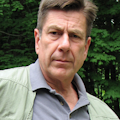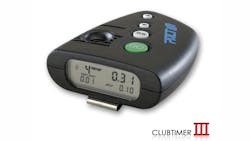Mike Seeklander's DVDs, the PACT timer, and the SPDtool Range Rod
The Influence of Competitive Shooting on Street Shooting
Clearly there's some overlap between competitive shooting and defensive shooting (whether in a civilian or law enforcement context). Competitive shooters have taught street shooters a lot over the decades...but there's also the flip side of that coin: police/self-defense shooting instructors teaching competitive/range techniques that had little use on the street, and were sometimes downright dangerous.
Since September 11, we have had a generation of special forces operators engaging in close quarter combat -- the kind of military fighting that most closely resembles what law enforcement and civilian self-defense shooters engage in. One thing that most SpecWar operators -- and all of the top tier units -- receive is regular instruction from top-level competitive shooters. Now, it sure would be interesting to see what part of the competitive instruction that the guys in these units have received that they value as a result of their copious combat experience. Actually, it's not hard to see. A lot of extraordinarily-trained, highly-experienced, supremely skilled combat veterans of these units are now teaching publically. And what they teach as defensive shooting fundamentals looks to have much more of a competitive influence to it than I would have ever guessed.
So what's that mean to us, as police officers and civilians? It tells me that our ideal instructor would be one that has both a significant competitive background as well as extensive experience in street-level and special-operations law enforcement. Relevant military experience would be a big plus, too. And no matter what his or her background and skill level, they'd also have to be superb teachers, because no matter how much you know, you can only teach what you can communicate.
Mike Seeklander
Which brings me to Mike Seeklander. Mike is a United States Practical Shooting Association Grandmaster, he's won a number of national level competitions, and placed in many more. He was a senior instructor at the Federal Law Enforcement Training Center in Charleston, S.C. Prior to that he served as the Branch Chief and Lead Instructor for the Federal Air Marshal firearms division, as well as instructing in the tactics and physical training divisions at the Federal Air Marshal training center in Atlantic City, N.J. He was responsible for the development, implementation and supervision of all firearms and tactical shoot-house instruction for the Federal Air Marshal service basic training. He is a combat veteran of Desert Shield and Desert Storm. Prior to receiving his honorable discharge in 2000, he was attached to a federal multi-agency task force investigating large-scale international drug trafficking. From 1995-98, he was employed by the Knox County (TN) Sheriffs Departments Corrections division and was a member of its Special Operations Response Team. From 1998-2001, he worked as a police officer for the Knoxville (TN) Police Department where he was assigned as a patrol officer and also as an investigator for the Organized Crime section, investigating narcotics and vice-related crimes at the local, state and federal levels. Not a one-trick (shooting) pony, Mike's also a long-time martial artist (and not the wussy stuff either), so he's completely competent when talking about the integration of empty hands and firearms at extreme close quarters.
And despite all of that, and despite appearing on a number of shooting and defensive-related television programs, he's also a nice guy! Moreover, Mike's done something else that tells me he's got his head straight about competitive vs. defensive shooting, about their overlaps and differences. He offers two seperate video/book programs. Each program consists of two DVDs that support a book. One two-DVD/book program is focused on competitive shooting, and the other on defensive shooting. Mike doesn't try and address the two different audiences in one program, and doesn't try and make you figure out which of what he's saying applies to you and which applies to a competitive shooter. In the DVDs he is an articulate and compelling presenter, and you clearly understand what he wants you to do and why.
In his defensive shooting program he covers what you need to know as a shooter: gear selection, grip proper and amount of sight alignment, movement, reloading, drills, etc. But he covers it strictly from the point of view of a defensive shooter, one informed by the relevant discoveries in competitive shooting, but not blindly applying competitive technique to defensive shooting. Case in point: the grip. Mike advocates a strong grip, reinforced by the "large dumb muscles" of the chest and back, with pressure in the appropriate places on the gun's frame. This in contrast to many competitive shooters who advocate a looser grip that "floats the gun". Both are appropriate, and you can shoot well with either, but Mike recognizes that a "floating" grip won't hold up under the extreme stress of a street gun fight, and he knows that most defensive shooters will be able to better control both recoil and flinch (which he shows you how to avoid in any case) with a stronger grip.
Mike goes further into mental and physical preparation for the gun fight. These subjects are touched on somewhat in other programs, but few go much into depth on physical conditioning and its relationship to gun skills. This emphasis shows that Mike clearly understands clearly that as I've said so many times, "there's more to defensive shooting than shooting". Then Mike covers in depth the actual training regimen that you need to accomplish the skills that he's showing you. Here his background as a top-level instructor of actual operators and as a curriculum developer shines through. He shows you how to build up to the skill, with increasing repetitions and variations and suggests a training log that actually makes sense (so many I've seen are, shall we say, not all that thoughtful; this one is). Finally there are the drills, laid out in detail, and they are easy and clear to follow. The DVDs support and complement the books, so they should be purchased as a set.
Here's the bottom line: If you do what Mike says -- and there's no reason you can't -- you'll be a vastly superior shooter, and a vastly superior fighter, at the end. Dedicate regular time over a season, say the six summer months (if it snows where you live), to go though the program. You'll be very glad you did.
The PACT Club Timer
Now here's the bottom line on timers: you need one. While ""there's more to defensive shooting than shooting", shooting is a critical part of it, and shooting performance is measured in time and bullet placement. You can't improve unless you know how you're shooting and if you're making progress. As the old saying goes "you can't manage what you don't measure".
The PACT Club Timer, now in its third generation, is the standard for club matches for a reason. It's also the timer that I prefer (which doesn't mean much) and the timer that Mike Seeklander recommends (which means a lot). It doesn't give you the phase of the moon, the rising astrological sign, and doesn't compute mean weighted averages across many strings of fire, but it does provide you with all you need to know: time to first shot, splits, and a couple other features that are useful for training either yourself or others. This means that it's easy to use and easy to learn, and you won't get all goofed up trying to program it. The form factor extremely ergonomic, and the buttons all intuitive and easy to use, and the "go" button is easy to find blind.
The Club timer can be set to either delay, instant on or par time mode. Delay Mode allows a delay from 2 to 3.5 seconds before the extra loud buzzer rings. In Instant Mode the Go button is pressed and held on the “Are You Ready?” command and the buzzer will sound instantly when the GO button is released. You want to get better at shooting? You have to have one of these.
Note: I preferred a pocket-sized bullet-list set of instructions for the PACT Club timer rather than the prose instructions that came with it. I made one up myself -- it's free to download from the SPDtool website (see below).
The SPDtool Range Rod
The Range Rod from SPDtool is an improved version of the Massad Ayoob-designed De-Jammer (made with Ayoob's blessing). This multi-function tool works as a barrel obstruction remover, a measuring scale for target groups, a magnetic parts retriever (with removable tip), and cleaning rod for 8-32 standard brushes (it accepts any 8/32 threaded device). Available at Brownells. This is an inexpensive, handy, must-have, often-used tool for serious shooters.
Here's a clue: the guys over at the Massachusetts Law Enforcement Firearms Instructors Association, whose Board has some serious experience under the collective belts of its members, has just ordered a bunch of them.
About the Author

Ralph Mroz
Ralph Mroz spent 20 years part-time as a police officer in Western Massachusetts, the last seven of which he was assigned to the county drug task force. He was a co-founder of the Police Officers Safety Association and was the developer and presenter of their training material. He was also the person in front of the camera for the Armed Response (www.armedresponsetraining.com) series of training DVDs.
